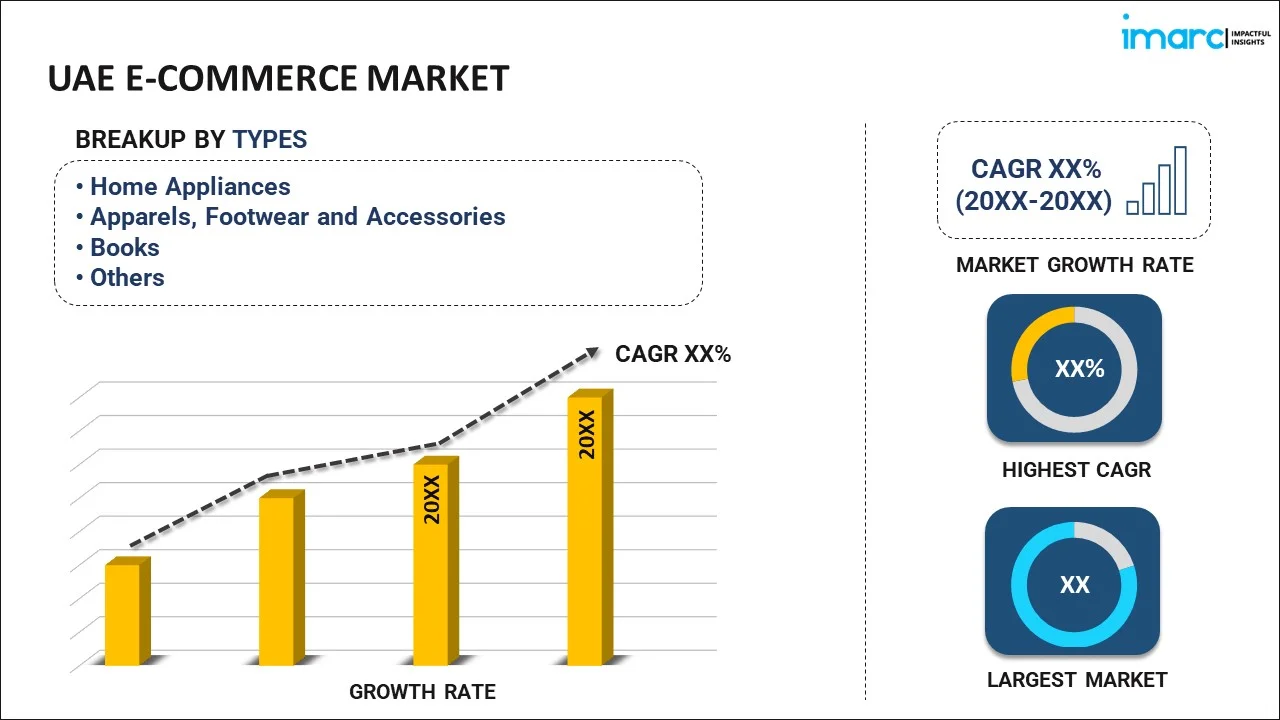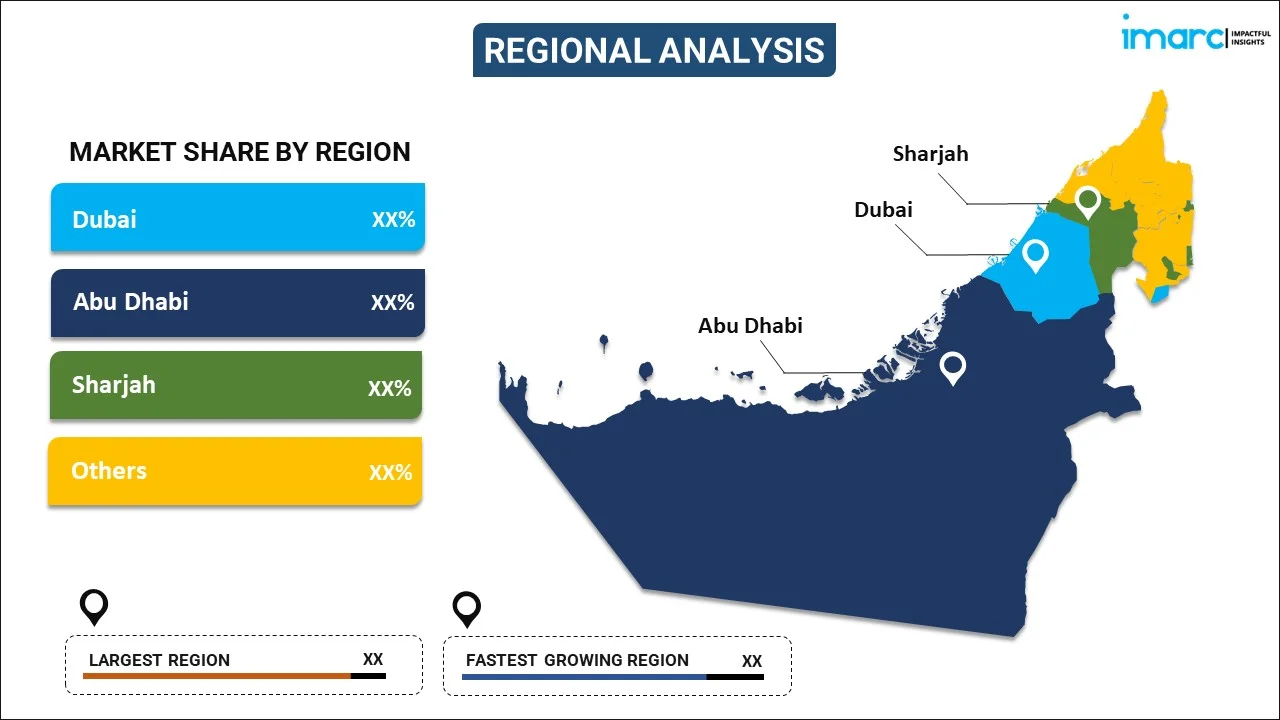
UAE E-Commerce Market Report by Types (Home Appliances, Apparels, Footwear and Accessories, Books, Cosmetics, Groceries, and Others), Transaction (Business to Business (B2B), Business to Consumer (B2C), Consumer to Consumer (C2C), and Others), and Region 2025-2033
UAE E-Commerce Market Overview:
The UAE e-commerce market size reached USD 125.0 Billion in 2024. Looking forward, IMARC Group expects the market to reach USD 776.2 Billion by 2033, exhibiting a growth rate (CAGR) of 21.4% during 2025-2033. The market is driven by the growing number of data centers, which provide improved security methods to secure critical customer and transaction data, along with the online purchasing from overseas vendors.
|
Report Attribute
|
Key Statistics
|
|---|---|
|
Base Year
|
2024 |
|
Forecast Years
|
2025-2033 |
|
Historical Years
|
2019-2024
|
| Market Size in 2024 | USD 125.0 Billion |
| Market Forecast in 2033 | USD 776.2 Billion |
| Market Growth Rate (2025-2033) | 21.4% |
UAE E-Commerce Market Trends:
Growing Number of Data Centers
E-commerce platforms require high performance and reliability, which data centers deliver. They ensure that websites and apps can handle high quantities of traffic without experiencing downtime, which is critical for retaining customer trust and happiness. Data centers provide improved security methods to secure critical customer and transaction data. This greater security promotes customer’s confidence in online commerce, resulting in higher adoption rates. As e-commerce enterprises are expanding in UAE, they want scalable solutions to handle larger volumes of data and traffic. Data centers provide scalable infrastructure, allowing e-commerce businesses to expand their operations without substantial delays or inconvenience. The proximity of data centers can reduce latency, resulting in speedier load times for e-commerce websites and applications. Faster load times improve the user experience, lowering bounce rates and boosting the possibility of a purchase. Data centers allow e-commerce enterprises to collect, store, and analyze massive volumes of data. This data can be utilized to personalize marketing, manage inventories, analyze customer behavior, and improve overall business tactics. Data centers offer sophisticated disaster recovery solutions that assure business continuity in the event of technological failures or other calamities. This dependability is crucial for e-commerce sites that operate 24/7.
E-commerce enterprises can use data centers to comply with local and international data storage and processing standards. This compliance is required for functioning in several marketplaces while keeping customer trust. Data centers facilitate the deployment of developing technologies, such as artificial intelligence (AI), machine learning (ML), and the Internet of Things (IoT). These technologies can improve the e-commerce experience by providing tailored suggestions, chatbots, and inventory management. According to an article published on the official website of the International Trade Administration (ITA), the UAE data center market is expected to grow at an average rate of 3.43% by 2027.
Online Purchasing from Overseas Vendors
An article published in 2023 on the website of the International Trade Administration (ITA) claims that online shoppers in the UAE made 58% of their online purchases from overseas vendors due to trust in gateway security, along with reliable and free shipping methods. Overseas sellers sell things that may not be widely available in the UAE. This comprises unusual, specialized, or niche commodities, as well as multinational brands that appeal to people seeking diversity and exclusivity. Products from international vendors may be less expensive due to lower manufacturing costs or different pricing methods. The availability of competitive price encourages more people to shop online globally. People in the UAE frequently seek out high-quality products from well-known global brands. The faith in these brands' quality and reputation stimulates demand for purchases from international providers. Authentic products are in high demand, particularly in the luxury, electronics, and fashion areas. Overseas dealers frequently offer a direct source for these authentic items, appealing to discerning customers.
Buying from international suppliers allows people to keep up with the global fashion, technology, and lifestyle trends. This access to the most recent trends increases the appeal of shopping from international sources. Advancements in logistics and international shipping are making it easier and faster for UAE buyers to receive goods from outside. Reduced shipping times and dependable delivery services attract foreign buying.
UAE E-Commerce Market News:
- May 2024: HSBC launched its new e-commerce digital payment platform Omni Collect in the UAE in partnership with leading Saudi-based fintech player, Geidea.
- February 2023: Etisalat UAE acquired Service Souk DMCC “ServiceMarket” to empower people, strengthen Smiles online marketplace presence and drive diversification of their businesses.
UAE E-Commerce Market Segmentation:
IMARC Group provides an analysis of the key trends in each segment of the market, along with forecasts at the country level for 2025-2033. Our report has categorized the market based on type and transaction.
Types Insights:

- Home Appliances
- Apparels, Footwear and Accessories
- Books
- Cosmetics
- Groceries
- Others
The report has provided a detailed breakup and analysis of the market based on the types. This includes home appliances, apparels, footwear and accessories, books, cosmetics, groceries, and others.
Transaction Insights:
- Business to Business (B2B)
- Business to Consumer (B2C)
- Consumer to Consumer (C2C)
- Others
A detailed breakup and analysis of the market based on the transaction have also been provided in the report. This includes business to business (B2B), business to consumer (B2C), consumer to consumer (C2C), and others.
Regional Insights:

- Dubai
- Abu Dhabi
- Sharjah
- Others
The report has also provided a comprehensive analysis of all the major regional markets, which include Dubai, Abu Dhabi, Sharjah, and Others.
Competitive Landscape:
The market research report has also provided a comprehensive analysis of the competitive landscape. Competitive analysis such as market structure, key player positioning, top winning strategies, competitive dashboard, and company evaluation quadrant has been covered in the report. Also, detailed profiles of all major companies have been provided.
UAE E-Commerce Market Report Coverage:
| Report Features | Details |
|---|---|
| Base Year of the Analysis | 2024 |
| Historical Period | 2019-2024 |
| Forecast Period | 2025-2033 |
| Units | Billion USD |
| Scope of the Report | Exploration of Historical and Forecast Trends, Industry Catalysts and Challenges, Segment-Wise Historical and Predictive Market Assessment:
|
| Types Covered | Home Appliances, Apparels, Footwear and Accessories, Books, Cosmetics, Groceries, Others |
| Transactions Covered | Business to Business (B2B), Business to Consumer (B2C), Consumer to Consumer (C2C), Others |
| Regions Covered | Dubai, Abu Dhabi, Sharjah, Others |
| Customization Scope | 10% Free Customization |
| Post-Sale Analyst Support | 10-12 Weeks |
| Delivery Format | PDF and Excel through Email (We can also provide the editable version of the report in PPT/Word format on special request) |
Key Questions Answered in This Report:
- How has the UAE E-commerce market performed so far and how will it perform in the coming years?
- What has been the impact of COVID-19 on the UAE E-commerce market?
- What is the breakup of the UAE E-commerce market on the basis of type?
- What is the breakup of the UAE E-commerce market on the basis of transaction?
- What are the various stages in the value chain of the UAE E-commerce market?
- What are the key driving factors and challenges in the UAE E-commerce?
- What is the structure of the UAE E-commerce market and who are the key players?
- What is the degree of competition in the UAE E-commerce market?
Key Benefits for Stakeholders:
- IMARC’s industry report offers a comprehensive quantitative analysis of various market segments, historical and current market trends, market forecasts, and dynamics of the UAE E-commerce market from 2019-2033.
- The research report provides the latest information on the market drivers, challenges, and opportunities in the UAE E-commerce market.
- Porter's five forces analysis assist stakeholders in assessing the impact of new entrants, competitive rivalry, supplier power, buyer power, and the threat of substitution. It helps stakeholders to analyze the level of competition within the UAE E-commerce industry and its attractiveness.
- Competitive landscape allows stakeholders to understand their competitive environment and provides an insight into the current positions of key players in the market.
Need more help?
- Speak to our experienced analysts for insights on the current market scenarios.
- Include additional segments and countries to customize the report as per your requirement.
- Gain an unparalleled competitive advantage in your domain by understanding how to utilize the report and positively impacting your operations and revenue.
- For further assistance, please connect with our analysts.
 Inquire Before Buying
Inquire Before Buying
 Speak to an Analyst
Speak to an Analyst
 Request Brochure
Request Brochure
 Request Customization
Request Customization




.webp)




.webp)












